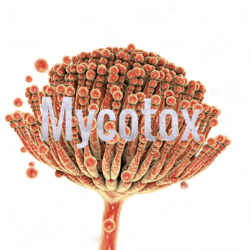The Molecular Menace Mycotoxins and Human Health
Lurking in our food supply, mycotoxins are toxic secondary metabolites produced by various fungal species, primarily from the genera Aspergillus, Penicillium, and Fusarium. These microscopic threats pose significant health risks to both humans and animals, with several hundred known mycotoxins identified as of January 2025
The Fungal Toxin Arsenal
The major mycotoxins of concern include:
- Aflatoxins: Produced by Aspergillus species, with aflatoxin B1 considered the most potent natural carcinogen.
- Ochratoxins: Synthesized by both Aspergillus and Penicillium species.
- Fumonisins: Primarily produced by Fusarium species.
- Trichothecenes: Including deoxynivalenol (DON), produced by various Fusarium species.
- Zearalenone: Another Fusarium-derived toxin.
- Patulin and Citrinin: Produced by both Penicillium and Aspergillus species.
Health Impacts: A Multi-System Assault
Mycotoxins can wreak havoc on multiple body systems, causing:
- Liver damage and cancer
- Kidney dysfunction
- Immune system suppression
- Neurological disorders
- Respiratory issues
- Gastrointestinal problems
- Reproductive and developmental toxicity
Ubiquitous Contaminants
These molecular menaces contaminate a wide range of food products:
- Cereals (maize, wheat, rice, barley)
- Nuts and oilseeds
- Spices
- Fruits, especially dried varieties
- Coffee and cocoa
- Animal-derived products (milk, eggs, meat) due to contaminated feed
Exposure occurs through ingestion, inhalation, or skin contact with contaminated materials
Ongoing Battle Against Mycotoxins
As of 2025, research efforts focus on:
- Enhancing detection methods in food and feed
- Developing more effective prevention and control strategies
- Understanding synergistic effects of multiple mycotoxins
- Investigating long-term impacts of chronic low-dose exposure
- Exploring potential medical applications of certain mycotoxins
The global community remains vigilant in monitoring and regulating mycotoxin levels to safeguard public health and ensure food safety

